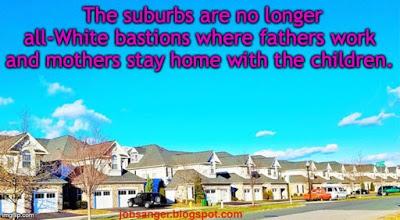 Donald Trump is doing well in rural areas of the country, and doing badly in urban areas. The election will be decided by how suburban voters go.
Donald Trump is doing well in rural areas of the country, and doing badly in urban areas. The election will be decided by how suburban voters go.Trump knows that he is in trouble in the suburbs. The 2018 election, and many recent polls, show the suburbs have turned away from him (and the Republican Party that has supported him).
Trump has decided that he can win suburban voters back by trying to scare them. He has told them that he will not allow low-income housing and apartments to come to those suburbs. He is trying to scare suburbanites by telling them he will keep minorities away from them.
There's a problem with that approach though. It supposes that the suburbs are White bastions. That may have been true back in the 1960's, but not anymore. Suburbs now have a diverse population, and are becoming more diverse all the time. If Trump didn't live in his bubble surrounded only by the rich, he would have known that.
Here is how David Byler, in The Washington Post, describes the flaws in Trump's suburban strategy:
Give President Trump this much: He has finally realized that the 2020 election will be lost and won in the suburbs. The question is whether his realization comes too late.
In recent weeks, Trump claimed that Democratic presidential nominee Joe Biden wants to “abolish the suburbs,” tweeted that he would preserve the American Dream for “Suburban Housewives of America” and bragged that his repeal of Obama-era housing regulations intended to prevent segregation would prevent suburbanites from being “bothered or financially hurt by having low income housing built in your neighborhood.”
It’s another step to stoke racial anxiety, this time among voters who moved leftward in the 2018 midterms and will be crucial in November. Other Republicans have tried it in cycles past. But the scare-the-suburbs tactic has flaws in 2020.
First, demographics. These communities are no longer all-White bastions where fathers work and mothers stay home with the children. These neighborhoods are racially diverse: According to a 2018 study, only 68 percent of suburbanites were White, 14 percent were Hispanic and 11 percent were Black. And no matter where they live, Pew Research Center found that the share of mothers who stay home with children declined from 49 percent in 1967 to 27 percent in 2016. The audience Trump believes he’s targeting — White stay-at-home suburban moms — may be smaller than he thinks.
Playing the race card is more likely to backfire now than in any time in a generation. In 2019, the libertarian Cato Institute found that 52 percent of Americans who live in the suburbs favor “building more houses, condos and apartments” in their community while 46 percent oppose the idea. According to YouGov, 50 percent of suburbanites think Biden would be better at handling race relations than Trump, and only 28 percent prefer Trump to Biden. And though it’s too early to tell whether this is a fad or a permanent trend, some suburbs may move left as city-dwellers, some of whom fear disease, have fled urban covid-19 hotspots.
Finally, Trump’s suburban pitch is off-key in an election dominated by the coronavirus. According to Gallup’s long-running “Most Important Problem” survey, concern about economic issues is at an all-time low, despite the economic impact of the pandemic. As of August, a 35 percent plurality thought that “coronavirus/diseases” was the most important problem facing the country, 22 percent believed it to be “the government/poor leadership,” and 10 percent named “race relations/racism” as most pressing. With voting set to begin in a few weeks, Trump’s handling of the virus and the broader recession are more important to voters than the specifics of housing policy.
It’s understandable that Trump would want to shift the narrative away from the virus — less than 40 percent of Americans approve of how Trump has handled the pandemic. And it makes sense to target the suburbs. Voters there make up roughly half of the electorate, and many still remember pulling the lever for tax-cutting Republicans since 2000. Trump needs votes and he needs them quickly, so he is playing on suburban voters’ basest fears to win back former Republicans and overcome Biden’s strength in cities.
But Trump may discover that, with kids going back to schools and colleges, voters in the suburbs have far too many other fears to worry about the homogeneity of their neighborhoods.

